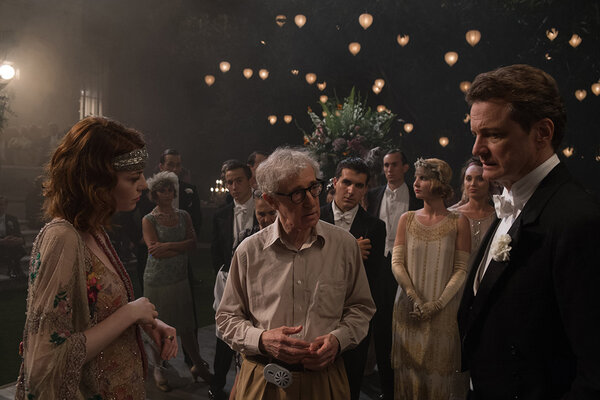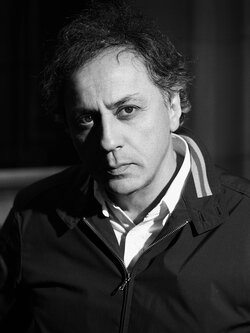Cinematographer Darius Khondji, AFC, ASC, discusses his work on "Magic in the Moonlight", a film by Woody Allen
Magic in the Moonlight : the witching hour, spiritualism, and flying mattresses. Director of photography Darius Khondji, AFC, ASC discusses his fourth film with Woody Allen.

Even though they always have jazz music during the credits, each Woody Allen film draws on different registers… After the portrait of a contemporary woman (Blue Jasmine), Magic in the Moonlight plunges us into the 1920s… What were his references ?
Darius Khondji : Woody Allen didn’t have particular requests. He just wanted a film that wouldn’t be too dark, rather glamorous, which would be full of the light-hearted ambience of the Côte d’Azur in the 1920s.
As far as I was concerned, I did a bit of research and was inspired by the work of Jacques-Henri Lartigue, who did a lot of photography of that region in the 20s. I did camera trials in 35mm, trying to go in that direction, playing with the old anamorphic lenses that I like so much and going for “autochrome” style pastel colours. I showed Woody those tests, he approved them, and from then on, he trusted me and left me completely free to make my own choices on set.
What lenses did you choose ?
DK : Panavision Series C. Julien Andreetti, my focus puller, and I did a lot of tests to put together a shooting pack using lenses available in France from Alga and others that we had sent from London. These lenses are very particular, besides their softness. I often chose to backlight the scenes with flares in order to play with their visual signature.
Like in the long shot from a crane that precedes Colin Firth’s arrival at the Cartledge home, with the sun backlighting the scene ?
DK : Woody Allen has always liked long shots. I recently re-watched his first films like Annie Hall and Manhattan, and there are really very few cuts ! This shot is actually a Steadicam movement on an inclined plane that was carried out by camera operator Jorg Widmer. Anecdotally, the shot we selected for the film is a retake.
In truth, when you work with him, you often have to retake three or four days of work. Often due to the acting, but sometimes also because of a detail or an accessory… Because he liked the light and the setting sun in the original shot, we had to repeat exactly the same thing a few days later, with the same positioning of the actress’ umbrella.
But there are also other scenes in this film that use flares, like the one on the banks of the little creek of Cap d’Antibes, or the spiritualism scene where I used candlelight instead of sun…
In the end, that’s what Woody Allen wanted for this film : stylize the image but keep the South of France sunlight that almost naturally pours out of the screen.
When did you shoot this film and how long did shooting take ?
DK : The film was shot between July and August 2013, in six-and-a-half weeks, taking into account scheduling constraints of both the locations and the actors. Besides the fact that we didn’t film in chronological order, it was complicated to mix two different locations within the same scene (the Cartledge house is a mix of indoor and outdoor sets in Cap d’Antibes and the town of Mouan-Sartoux) and to take “retakes” in often variable lighting conditions. In any case, shooting a film mostly out of doors in full sunlight with so much dialogue is always a challenge for the director of photography !
There is a slightly Hollywood feel to this movie that isn’t usual in Woody Allen films. I’m thinking specifically about the camera movements or the crane shots, such as the scene where the car leaves the hospital…
DK : It is true that I rarely use cranes on the films I shoot with him. Besides the scene outside of the hospital, we used a rather classic shot in front of the stairs with the car ; we also used a vehicle-mounted crane on the road in Esterel. For that, we looked at the shots Hitchcock made in To Catch a Thief, and tried to reproduce the same set used at the time.
In that scene, and especially the following scene with the storm and the night in the observatory, there is a bit of a “studio” or kitschy feel to the image, which Woody wanted to keep. Like the lightning that was exaggerated in postproduction, or the discovery of the night sky and the moon that feel very…romantic.
That observatory scene is, in a way, the centre of the film. It’s the only scene with colder tones, and especially the only one where you see the moonlight that lends its title to the film ! Tell me a bit about the way this set was lit…
DK : We set up a very large lantern high up in the dome of the observatory, it took up almost the entire space. Just a shower of even light, that acts as a key light in the wide shot. Then, I simply re-balanced the actors’ faces with OctaPlus spots, as I often did on this film. These are photography spots, manufactured by Chimera, which are special in that they have a very thick diffusion on fabric. This gives a very natural-feeling light that you can very easily use in dark ambiances. At the same time, it is light and quicker to set up than Chinese lanterns thanks to their contrast control.
The ball was a big set up, too…
DK : The ball scene was filmed outside at night in front of the most ornate façade of the Eden Roc villa at Cap d’Antibes. We really wanted a Great Gatsby feel to this scene.
The wide shot is lit by a gigantic lantern placed above the roof of the house as a backlight, and it was reinforced by a series of PAR spots aimed at the dance floor and the stairs from the cornice.
Didn’t you use LED lighting ?
DK : Yes, sometimes I use panels, especially when I am working with a particular American gaffer who uses them a lot. But I always feel like the result is too cosmetic… a little too perfect, like Kinos. You’ve got to play around with them and diffuse them to make the final result interesting.
The end scene, around the swings and the garden, was another challenge… How did you manage to keep the late afternoon feeling even though the scene was evidently filmed over the course of a few days ?
DK : This shot epitomizes what I was saying about the difficulties of filming long talky shots outdoors in the daytime and still ensuring continuity… It was also shot at various times, with “retakes” over the course of the day. In order to keep the light consistent, I used a range of Airstar “flying mattress” lanterns, which allowed me to block the direct sunlight for the close-ups. Then I had to adjust the set and a few powerful light sources that were sometimes placed in the background in order to use natural light sometimes right up to the sunset. That was the case for the last shot of Emma Stone leaving, which was filmed with the last rays of the sun, and which, I think fits well with this bitter-sweet ending.
A word regarding postproduction ?
DK : The development of the negatives and the processing of the dailies were carried out by Arane Gulliver laboratory, with Jean René Faillot at its head, who I sincerely thank for his careful attention and the quality of his work.
Then, postproduction was carried out in New York, by Deluxe and Box laboratories, where my colour painter, Pascal Dangin, put the final touches on the image. For the time being, I continue to work with traditional film stock, as I did this summer in Rhode Island with Woody Allen for his new film that we have just filmed together. This method still functions perfectly well, and isn’t necessarily much more expensive so long as you don’t use kilometres of film. Why give it up ?
(Interview conducted by François Reumont and translated from French by Alex Raiffe)
 En
En Fr
Fr






